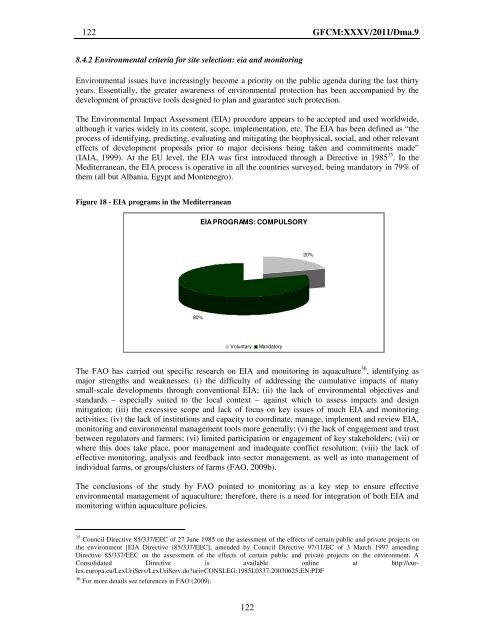Site selection and carrying capacity in Mediterranean ... - FAO Sipam
Site selection and carrying capacity in Mediterranean ... - FAO Sipam
Site selection and carrying capacity in Mediterranean ... - FAO Sipam
Create successful ePaper yourself
Turn your PDF publications into a flip-book with our unique Google optimized e-Paper software.
122 GFCM:XXXV/2011/Dma.9<br />
8.4.2 Environmental criteria for site <strong>selection</strong>: eia <strong>and</strong> monitor<strong>in</strong>g<br />
Environmental issues have <strong>in</strong>creas<strong>in</strong>gly become a priority on the public agenda dur<strong>in</strong>g the last thirty<br />
years. Essentially, the greater awareness of environmental protection has been accompanied by the<br />
development of proactive tools designed to plan <strong>and</strong> guarantee such protection.<br />
The Environmental Impact Assessment (EIA) procedure appears to be accepted <strong>and</strong> used worldwide,<br />
although it varies widely <strong>in</strong> its content, scope, implementation, etc. The EIA has been def<strong>in</strong>ed as “the<br />
process of identify<strong>in</strong>g, predict<strong>in</strong>g, evaluat<strong>in</strong>g <strong>and</strong> mitigat<strong>in</strong>g the biophysical, social, <strong>and</strong> other relevant<br />
effects of development proposals prior to major decisions be<strong>in</strong>g taken <strong>and</strong> commitments made”<br />
(IAIA, 1999). At the EU level, the EIA was first <strong>in</strong>troduced through a Directive <strong>in</strong> 1985 35 . In the<br />
<strong>Mediterranean</strong>, the EIA process is operative <strong>in</strong> all the countries surveyed, be<strong>in</strong>g m<strong>and</strong>atory <strong>in</strong> 79% of<br />
them (all but Albania, Egypt <strong>and</strong> Montenegro).<br />
Figure 18 - EIA programs <strong>in</strong> the <strong>Mediterranean</strong><br />
80%<br />
EIA PROGRAMS: COMPULSORY<br />
Voluntary M<strong>and</strong>atory<br />
The <strong>FAO</strong> has carried out specific research on EIA <strong>and</strong> monitor<strong>in</strong>g <strong>in</strong> aquaculture 36 , identify<strong>in</strong>g as<br />
major strengths <strong>and</strong> weaknesses: (i) the difficulty of address<strong>in</strong>g the cumulative impacts of many<br />
small-scale developments through conventional EIA; (ii) the lack of environmental objectives <strong>and</strong><br />
st<strong>and</strong>ards – especially suited to the local context – aga<strong>in</strong>st which to assess impacts <strong>and</strong> design<br />
mitigation; (iii) the excessive scope <strong>and</strong> lack of focus on key issues of much EIA <strong>and</strong> monitor<strong>in</strong>g<br />
activities; (iv) the lack of <strong>in</strong>stitutions <strong>and</strong> <strong>capacity</strong> to coord<strong>in</strong>ate, manage, implement <strong>and</strong> review EIA,<br />
monitor<strong>in</strong>g <strong>and</strong> environmental management tools more generally; (v) the lack of engagement <strong>and</strong> trust<br />
between regulators <strong>and</strong> farmers; (vi) limited participation or engagement of key stakeholders; (vii) or<br />
where this does take place, poor management <strong>and</strong> <strong>in</strong>adequate conflict resolution; (viii) the lack of<br />
effective monitor<strong>in</strong>g, analysis <strong>and</strong> feedback <strong>in</strong>to sector management, as well as <strong>in</strong>to management of<br />
<strong>in</strong>dividual farms, or groups/clusters of farms (<strong>FAO</strong>, 2009b).<br />
The conclusions of the study by <strong>FAO</strong> po<strong>in</strong>ted to monitor<strong>in</strong>g as a key step to ensure effective<br />
environmental management of aquaculture; therefore, there is a need for <strong>in</strong>tegration of both EIA <strong>and</strong><br />
monitor<strong>in</strong>g with<strong>in</strong> aquaculture policies.<br />
35 Council Directive 85/337/EEC of 27 June 1985 on the assessment of the effects of certa<strong>in</strong> public <strong>and</strong> private projects on<br />
the environment [EIA Directive (85/337/EEC], amended by Council Directive 97/11/EC of 3 March 1997 amend<strong>in</strong>g<br />
Directive 85/337/EEC on the assessment of the effects of certa<strong>in</strong> public <strong>and</strong> private projects on the environment. A<br />
Consolidated Directive is available onl<strong>in</strong>e at http://eurlex.europa.eu/LexUriServ/LexUriServ.do?uri=CONSLEG:1985L0337:20030625:EN:PDF<br />
36 For more details see references <strong>in</strong> <strong>FAO</strong> (2009).<br />
122<br />
20%
















